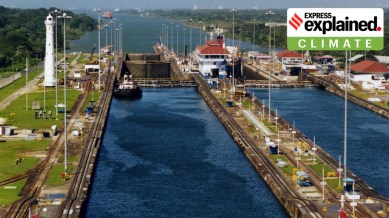Why climate change poses an existential threat to Panama Canal
The Panama Canal, connecting the Atlantic and Pacific Oceans through the Isthmus of Panama, was opened to ships 110 years ago. Today, it faces an existential threat

The first ship passed through the Panama Canal on August 15, 1914, exactly 110 years ago.
The 82-km canal, which remains one of the greatest feats of engineering in history, is a shortcut for ships travelling between the Atlantic to the Pacific Oceans by cutting through the Isthmus of Panama in Central America. It saves approximately 12,600 km in a trip between New York and San Francisco, and is one of the most important shipping lanes in the world.
Traffic now has been restored to upwards of 35 ships a day, experts know that this is a temporary respite, with climate change posing an existential threat to the canal. Here is how.
System of water elevators
The Panama Canal is not a simple channel of water connecting two larger water bodies — it is a sophisticated, highly-engineered system which uses a system of locks and elevators to take ships from one end to the other.
This is needed because the two oceans that the Panama Canal connects do not lie at the same elevation, with the Pacific slightly higher than the Atlantic. This difference means that for a ship entering the canal through the Atlantic, it needs to gain elevation during its journey to the Pacific. This is achieved using a lock system which lifts and drops vessels to the required sea level at either end of the canal.
Basically, locks are either flooded (to gain elevation) or drained (to lose elevation), and act as water elevators. In total, the system comprises three sets of locks — 12 locks in total — which are serviced using artificial lakes and channels. Here is how a set of locks works.
- A ship approaches the first, lowest chamber of a lock, which lies at sea level;
- The locked gate opens to allow the ship into the chamber, and closes behind it;
- The valve between the first and second chamber (at a higher elevation) is opened to increase the water level of the first chamber;
- The gate between the two chambers is opened once the water level is equalised, and the ship enters the next chamber.
This process is repeated to gain elevation. The opposite principle works when losing elevation. Ships entering from the Atlantic side first gain 26 m in elevation at Lake Gaitan, before losing some elevation closer to the Pacific side (See Graphic).
Threat of climate change
The Panama Canal needs massive amounts of fresh water to facilitate the passage of ships using this system of locks. Most of this water is supplied from Lake Gatun using the force of gravity (no pumps are needed).
According to a report by The New York Times, the passage of a single ship needs more than 50 million gallons (almost 200 million litres) of water. Thus, every day, the canal uses two-and-a-half times the amount of water consumed by the 8 million residents of New York City.
Last year, lower water levels in Lake Gatun meant that far fewer ships could pass through the canal every day, and those which did pass, often had to reduce their cargo to make the passage. While water from the oceans can be used to work the system of locks, this increases the salinity of Lake Gatun, which is also the source of drinking water for more than half of Panama’s 4.4 million people.
While better rainfall has meant that things are better this year, experts say that this is but a momentary respite. “Rain not only washes the streets, it washes our minds and we think the problem is gone,” Carlos Urriola, president of SSA International, which operates shipping terminals around the world, including at the Panama Canal, told The NYT. “The problem of water is a permanent one.”
This permanent problem stems out of a much greater one which threatens humanity — climate change. Years of extreme rainfall deficits are not unheard of in Panama. But they have become increasingly common, and experts say as Earth heats up further, they might become even more common in the future.
“Historically there has been a [rainfall] shortage on average once every 20 years due to major El Niño events. In the last 26 years this is the third major rainfall deficit. So it seems that something is changing our rainfall patterns,” Steven Paton, a veteran climate change expert at the Panama-based Smithsonian Tropical Research Institute, told The Guardian in 2023. What happened in 2023, statistically “has no analogue in the previous 100 years of data,” he said.
A contentious solution
The fix proposed by the Panama Canal authorities is to create a second source of water for the canal by damming the Rio Indio. This is not the first time such a proposal has been made, but previously, an old law made the river untouchable. Last month, Panama’s Supreme Court struck down that limitation, opening doors for the building of a $1.6 billion dam which authorities say will fix the problem for at least the next 50 years.
But not everyone is happy with this proposal. The reservoir which would service the canal during droughts will also flood the homes of 2,000 people, predominantly from the lower socio-economic strata. They will have to be relocated, and will lose lands and livelihoods that they have had for decades.
“They want to relocate us, but we don’t think that way,” Olegario Hernandez, one of the many people who will be displaced by the Rio Indio dam, told The NYT. “There’s no place better.”
With inputs from The New York Times